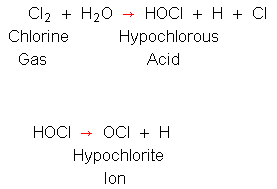Water Disinfection System
Chlorine systems are effective in removing bacteria and viruses from water sources. These systems are relatively inexpensive that is why it remains so popular. WCSP typical water disinfection system consists of a chemical feed pump which meters precise amounts of diluted chlorine into the incoming water stream. This chlorinated water is then contained in a reservoir called a ‘contact tank’. These tanks varied in their capacity. For optimal results, Chlorine needs at least 20 minutes of contact time After this point of operation, remove excess of chlorine for maintaining taste and odor.
Salient Features
- Chlorine dosing system with monitoring & control
- Kill harmful coliform and E.coli bacteria
- Eliminate sulfur (hydrogen sulfide) odors
- Oxidize iron, manganese for easier filtration
- Low cost and effective
- Our chlorination system works well for drinking & process water. One can online monitor & control chlorine dose, on the other hand, if we want to do it manually we can use chlorine testing kits for chlorine adjustment.

Mastering Water Safety: A Deep Dive into the World of Water Disinfection Systems
Embark on a journey of unrivaled water safety with our comprehensive guide to Water-Disinfection Systems. In this exploration of cutting-edge technology, we delve into the intricate mechanisms that define these systems, ensuring a meticulous purification process that goes beyond mere clarity. Our focus on Water-Disinfection Systems extends far beyond the household, revealing their pivotal role in safeguarding water sources across diverse sectors.
Within the realm of water treatment, these systems emerge as stalwarts against waterborne threats, employing a sophisticated blend of technologies. From the potent sterilization capabilities of UV rays to the precision of chemical disinfection, our guide demystifies the arsenal of tools that Water Disinfection Systems utilize to neutralize harmful microorganisms. We explore their adaptability across various applications, from residential use to industrial processes, elucidating how these systems stand as guardians of water quality.
Our narrative seamlessly weaves in related keywords, illuminating the broader landscape of water purification. This guide is not just an informational resource; it’s a journey that fosters a profound understanding and appreciation for the crucial role Water Disinfections Systems play in securing the purity of our water sources. So, dive in and empower yourself with the knowledge needed to master water safety in an ever-evolving world.
In this day and age, opting for a Water Disinfection System and an Ultra-filtration Water Plant proves to be the optimal choice for us. Additionally, individuals utilize a Filtration Water Plant to treat water.
A Water Disinfection System is a technology designed to eliminate or inactivate harmful microorganisms, such as bacteria, viruses, and parasites, from water to ensure it is safe for consumption and use.
Water Disinfection Systems use various methods, including chemical disinfection (such as chlorination or ozonation), ultraviolet (UV) radiation, and filtration, to kill or deactivate microorganisms present in water.
Water disinfection is crucial to prevent waterborne diseases. It ensures that water is free from pathogenic microorganisms, safeguarding public health and preventing the spread of waterborne illnesses.
Water Disinfection Systems are effective against a broad spectrum of microorganisms, including bacteria, viruses, parasites, and some types of algae. The specific effectiveness depends on the disinfection method used.
Yes, there are various methods, such as chemical disinfection using chlorine or ozone, ultraviolet (UV) radiation, filtration, and advanced oxidation processes. Each method has its advantages and is suitable for different applications.
While ensuring safe drinking water is a primary concern, water disinfection is also essential for recreational water (pools, lakes), industrial processes, and wastewater treatment to prevent the spread of diseases and contamination.
Maintenance frequency varies based on the type of disinfection system and water quality. Regular checks, cleaning, and, if necessary, replacement of components are essential to ensure optimal performance.
Water Disinfection Systems primarily target microorganisms. While some methods, like activated carbon filtration, can reduce certain chemical contaminants, additional water treatment processes may be required for comprehensive chemical removal.
Yes, Water Disinfection Systems come in various sizes and configurations, making them suitable for both residential and industrial applications. The scale and specific requirements may vary based on the intended use.
UV disinfection is highly effective against a wide range of microorganisms by disrupting their DNA, preventing reproduction. It is a chemical-free and environmentally friendly method, commonly used in both residential and industrial water treatment systems.
